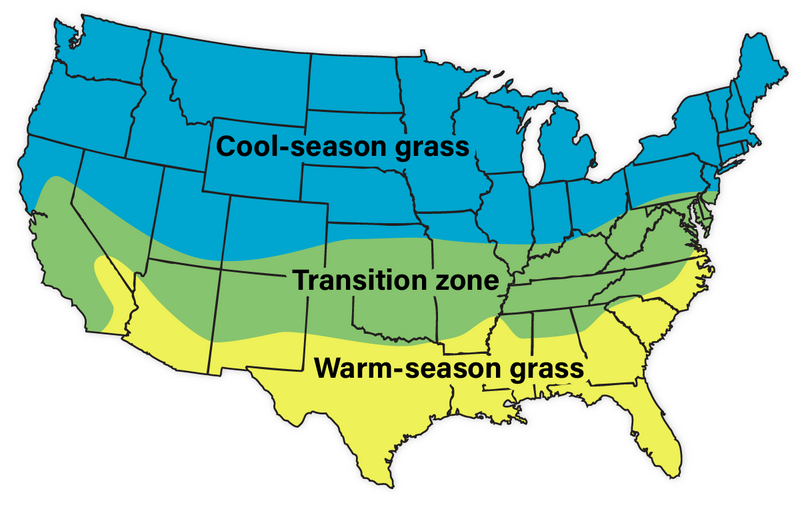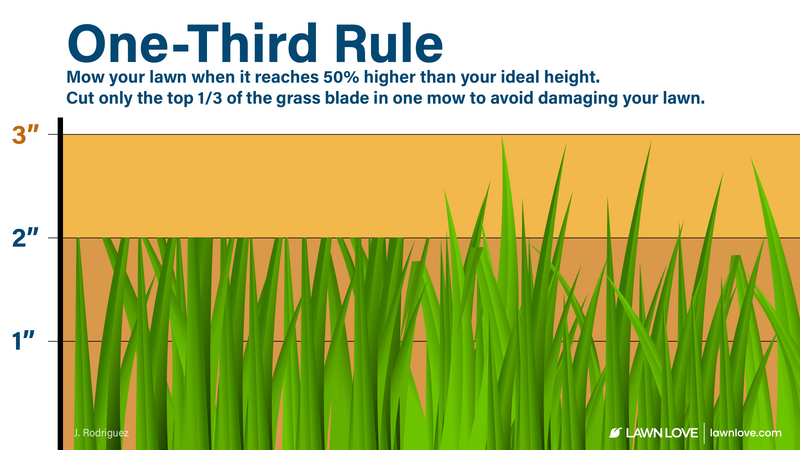
Zoysiagrass is a popular turfgrass for many homeowners in the southern and middle sections of the country. Are you looking for a dense stand of turf? That’s Zoysia. Do you prefer a fine-bladed lawn? Zoysiagrass has you covered. Prefer a thicker-bladed lawn instead? Yes, there are varieties for that, too.
Zoysiagrass (or Zoysia, for short) offers many varieties that suit lawns in the warm-season and transitional zones. Learn more about Zoysia, from its Asiatic beginnings to its present-day use in the modern home lawn.

Zoysia at a glance
Classification: Warm-season grass
Spreads by: Stolons and rhizomes
Shade tolerance: Tolerates light to moderate shade
Drought resistance: High
Foot traffic tolerance: High
Maintenance needs: Low to moderate nitrogen requirement; moderate mowing frequency
Mowing height: 1-2.5 inches
Potential for disease: Not prone to disease and insects; good disease tolerance overall
Soil pH: 6-6.5
Soil type: Well-draining, some cultivars more tolerant of a wide range of soils than others
Other notes: Moderately salt tolerant; cut with sharp mower blade; mow taller if grass is in partial shade

What is Zoysiagrass?
Zoysia is a warm-season turfgrass that originated in parts of Southeast Asia, Japan, and China and came to the U.S. in the late 1800s and early 1900s. During the 20th century, turf breeders cultivated new Zoysia varieties that are well suited for warm-season and transitional zone lawns in the U.S., including Hawaii.
In general, Zoysia has some shade tolerance (though it prefers full sun) and some Z. japonica cultivars have good cold tolerance, making them a popular choice in the transition zone.
Other grasses, such as some cultivars of bermudagrass, may fail in the transition zone due to the cold winters while cool-season grasses like Kentucky bluegrass can’t handle the warm summers. Zoysia fills a needed niche in these areas.
Homeowners with kids or pets appreciate that Zoysiagrass is a dense grass that has an excellent resistance to heavy foot traffic and other wear. In addition, if damage occurs, Zoysia has a strong ability to recover. There is one downside: since Zoysia is a slow grower, the recovery will be slow.
These traits may vary slightly from one cultivar to another, though, so research the different cultivars to make the best decision. Zoysia’s dense growing habit also means less weeding for you as this grass does an excellent job of outcompeting many weeds.
In addition to these benefits, Zoysiagrass is popular in coastal areas due to its high salt tolerance.
The three most common Zoysia species are Zoysia japonica, Zoysia matrella, and Zoysia pacifica.

Zoysia japonica:
✓ Also known as Japanese or Korean lawngrass
✓ Coarse-textured leaves
✓ Best cold tolerance among the three species
✓ Came to the U.S. in the late 1800s

Zoysia matrella:
✓ Also called Manilagrass
✓ Fine-textured leaves
✓ Grows more slowly and is less cold hardy than Z. japonica
✓ Came to the U.S. in the early 1900s from Manil

Zoysia pacifica (formerly known as Zoysia tenuifolia):
✓ Also known as Korean velvet grass or Mascarenegrass
✓ The look of this grass is often described as puffy or fluffy
✓ Blades are short and very fine
✓ Very low tolerance for cold weather — good for some coastal areas, Central and South Florida, and similar climates
✓ Withstands a moderate amount of traffic but is usually planted as an ornamental plant or ground cover
✓ Produces a clumpy, very dense grass
Within these three species are many different varieties (also called cultivars). You may see names such as Meyer, El Toro, Emerald, and Zeon. Other popular cultivars are Zenith, Empire, and Zorro. Check with your local Extension Office to see which cultivars are recommended in your area.

Pros and cons of Zoysia
No one grass is right for every lawn, so check out these pros and cons to help you learn more about Zoysia’s strengths and weaknesses.
Pros
✓ One of the best “barefoot grasses”— soft to walk on
✓ A true competitor — crowds out most weeds on its own (less weeding!)
✓ Likes full sun but will tolerate light shade (may thin out in shady areas)
✓ Good salt tolerance (great for coastal areas)
✓ Available in fine-bladed and wide-bladed varieties
✓ Works well in a variety of soil types — sand, loam, and clay
✓ Good traffic tolerance — great for kids and pets
✓ Cold-tolerant
✓ Generally drought tolerant — will go brown (dormant) but will likely survive
✓ Many varieties to choose from
✓ Works throughout the warm-season states and into the transition zone
✓ Works in the transition zone where cool-season grasses can’t thrive due to too much heat and other warm-season grasses fail due to the cold winters
✓ Can be managed as either a low-maintenance or a high-maintenance turf
Cons
✗ Slow grower
✗ Slow to establish from grass plugs or seed; sod is recommended
✗ Goes brown during a drought
✗ Good ability to recover from wear, but recovery is slow
✗ Since seeding is not usually recommended, establishing new Zoysia can be costly
✗ Thatch can be a problem if too much nitrogen is applied

How to establish Zoysia
Most experts recommend using sod to establish a Zoysia lawn. Plan to lay the sod in spring, late summer, or fall for best results. Sodding takes proper soil preparation and watering to get it off to a good start, but for many, the higher-quality result is worth it.
It is possible to buy Zoysia grass seed for Zoysia japonica grasses, but this is not normally recommended for a high-quality turf. Zoysia lawns are more difficult to establish via seed because of weed pressure and the time it takes to get a full stand of grass.
Remember that timing is everything when you’re seeding warm-season grasses. Spring is the best time to establish a Zoysia lawn from seed. This gives the lawn from late spring through summer and into fall (a full growing season) to grow before it goes dormant for the winter.
Although using seed is less expensive, keep in mind that a slow-growing grass like Zoysia will require extra care on your part to keep weeds at bay as it establishes.
Sprigs and plugs are also available for Zoysia grasses, but they are slow to establish, taking a full season or longer to completely cover the yard.

How much does Zoysia cost?
Zoysia sod: Zoysia sod costs between 62 to 85 cents per square foot.
Zoysia seed: A 5-pound bag of Zoysia seed starts at $40 for up to 500 square feet of new lawn.
Zoysia plugs: A 64-count set of Zoysia plugs will be around $110 for 144 square feet of coverage once established.

Caring for Zoysia
Mowing
In home lawns, mow Zoysia from 1-2.5 inches, never taking off more than one-third of the grass blade per mow. (This is called the one-third rule of mowing.)
Water
Let’s not forget the importance of watering deeply but infrequently. A good rule of thumb is to water 1 inch per week, although sandy soils may need more frequent watering.
If you turn on your sprinklers, early morning is the best time to water. Be sure to finish watering by 10 a.m. at the latest.
Fertilization
Zoysia requires from 0.5 to 2.5 pounds of nitrogen per 1,000 square feet per year. Fertilizer rates will vary depending on where you live, your soil type, organic matter, sun or shade (less in shade), and the results of your soil test.
Look online to view your state’s lawn calendar for local tips on when and how much to fertilize your Zoysia lawn.
In general, plan to do three fertilizer applications per year: one in late spring/early summer, mid-summer, and late summer. There are exceptions, of course. Lawns in South Florida, for example, can be fertilized year-round.
Pro Tip: Don’t forget to use a mulching mower and leave the grass clippings on the grass as a free fertilizer treatment for your lawn.

Dethatching and aeration
Thatch, in particular, can be a problem with certain varieties of Zoysia or as a result of excess nitrogen. Once the thatch layer reaches ½ to 1 inch, it’s time to think about dethatching.
State recommendations vary on whether to dethatch Zoysia since it can be slow to recover, so check your state’s Extension Bulletin or call your local Extension Office for its advice. One strategy is to do several light dethatching sessions instead of one deep pass.
Dethatching and aeration should be done in late spring or early summer when the grass is going into its growing season.
If your soil is compacted, core aeration is a good cultural practice to consider. A core aerator pulls cores from the soil to allow more air and water to the roots. This results in less soil compaction which helps the grass grow stronger and strengthens it against stresses such as disease and drought.

Disease, insects, and weeds
Your state’s lawn calendar will likely have recommendations on disease, insects, and weeds, as well. As with all grass, the best defense against lawn maladies, such as weeds, insects, or disease, is a good lawn care offense.
Disease: Although disease pressure is generally low, Zoysia can be susceptible to the following:
- Large patch
- Root decline
- Spring dead spot
- Rust
- Curvularia
- Leaf spot

Insects: Common insects include:
- Zoysiagrass mites
- Grubs
- Mole crickets
- Hunting billbugs
- Armyworms
- Chinch bugs
- Sod webworms
- Nematodes
Weeds: Although weed control is not usually a significant issue due to its dense growth habit, Zoysia can tolerate a wider range of herbicides than centipede or St. Augustine. Mechanical methods (such as hand-pulling) and organic sprays are other options for ridding the lawn of weeds.
Pro Tip: Research different Zoysia cultivars to get the grass with the best features for your lawn and local climate. Don’t be afraid to consider newer cultivars, either. Turfgrass breeders release new ones frequently, such as the new Lobo™ cultivar from NC State that was released at the end of 2021.
Some information sourced from Fundamentals of Turfgrass Management, 5th ed. by Christians, Patton, and Law.
If you think a Zoysia grass lawn may be right up your alley, contact one of our local lawn care professionals today. They can help you select, install, and care for your grass so you can spend your free time doing what matters most.
Main Photo Credit: Bill Wilson | Flickr | CC BY-SA 2.0